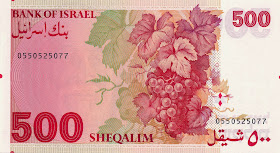Obverse: Portrait of Baron Edmond de Rothschild; a group of agricultural workers; the denomination "Five Hundred Sheqalim" and "Bank of Israel" in Hebrew.
Reverse: Cluster of grapes; names of 44 settlements in the Land of Israel in two lines of microprint, "500 Sheqalim" and "Bank of Israel" in Arabic and English.
Watermark: Portrait of Edmond de Rothschild.
Security thread: In the middle of the note.
Look-through: Four rhombi on the front merge with two rhombi on the back to form a Star of David when held against the light.
Sign for the blind: A small circle in the lower right-hand corner of the front.
Colour of numbering: Black.
Signatures: Governor of the Bank Moshe Mandelbaum; Chairman of the Advisory Council Haim Barkai.
Design: Zvi Narkiss.
Year: 1982.
Date of issue: December 1, 1982.
Ceased to be legal tender: September 4, 1986.
Size: 138 X 76 mm.
Dominant colour: Red.
Israel Banknotes - Israel Paper Money
Currency reform 1980, 10 Lirot = 1 Sheqel.
500 Sheqalim 1000 Sheqalim 5000 Sheqalim 10000 Sheqalim
Edmond James de Rothschild
Baron Edmond Benjamin James de Rothschild (19 August 1845 – 2 November 1934) was a French member of the Rothschild banking family. A strong supporter of Zionism, his generous donations lent significant support to the movement during its early years, which helped lead to the establishment of the State of Israel.
A member of the French branch of the Rothschild banking dynasty, he was born in the Paris suburb of Boulogne-Billancourt, Hauts-de-Seine, the youngest child of James Mayer Rothschild and Betty von Rothschild. He grew up in the world of the Second Republic and the Second Empire and was a soldier "Garde Mobile" in the first Franco-Prussian War. In 1877 he married Adelheid von Rothschild of Naples, the daughter of Wilhelm Carl von Rothschild, with whom he had three children: James Armand Edmond, Maurice Edmond Karl and Miriam Caroline Alexandrine.
Edmond de Rothschild inherited Château Rothschild, Boulogne-Billancourt and owned the Château Rothschild d'Armainvilliers in Gretz-Armainvilliers in the Seine-et-Marne département.
Edmond took little active part in banking but pursued artistic and philanthropic interests, helping to found scientific research institutions such as the Institut Henri Poincaré, the Institut de Biologie physico-chimique, the pre-Centre National de la Recherche Scientifique, the Casa Velázquez in Madrid, and the French Institute in London. He served as a member of the French Académie des Beaux-Arts and through it sponsored the archaeological digs of Charles-Simon Clermont-Ganneau in Egypt, Eustache de Lorey in Syria, and Raymond Weill in Palestine.
Edmond de Rothschild acquired an important collection of drawings and engravings that he bequeathed to the Louvre consisting of more than 40,000 engravings, nearly 3,000 drawings, and 500 illustrated books. Included in this gift were more than one hundred engravings and drawings by Rembrandt. A portion of his art collection was bequeathed to his son James A. de Rothschild and is now part of the National Trust collection at Waddesdon Manor. However, in 1882 Edmond cut back on his purchases of art and began to buy land in Southern Syria (Ottoman Palestine).
He became a leading proponent of the Zionist movement, financing the first site at Rishon LeZion. In his goal for the establishment of a Jewish homeland, he promoted industrialization and economic development. In 1924, he established the Palestine Jewish Colonization Association (PICA), which acquired more than 125,000 acres (50,586 ha) of land and set up business ventures.
Edmond de Rothschild also played a pivotal role in Israel's wine industry. Under the supervision of his administrators in Ottoman Palestine, farm colonies and vineyards were established, and two major wineries were opened in Rishon LeZion and Zikhron Ya'akov. It is estimated that Rothschild spent over $50 million in supporting the settlements, and backed research in electricity by engineers and financed development of an electric generating station.
Jews and Arabs lived amicably on Rothschild's land, with no Arab grievances, even in the worst periods of disturbance. According to historian Albert M Hyamson, "Rothschild recognised that the overriding interest of the Jews of Palestine was the confidence and the friendship of their Arab neighbours. The interests of the Arab cultivators of the land he bought were never over looked, but by development he made this land capable of maintaining a population ten times its former size." In a 1934 letter to the League of Nations, Edmond de Rothschild stated that "the struggle to put an end to the Wandering Jew, could not have as its result, the creation of the Wandering Arab."
Baron de Rothschild died in 1934 at Château Rothschild, Boulogne-Billancourt. His wife died a year later on 29 December 1935. They were interred in Père Lachaise Cemetery in Paris until April 1954 when their remains were transported to Israel aboard a naval frigate. At the port of Haifa, the ship was met with sirens and a 19-gun salute. A state funeral was held with former Prime Minister David Ben-Gurion giving the eulogy following which Edmond de Rothschild and his wife were reinterred in Ramat HaNadiv Memorial Gardens near the towns of Zichron Ya'akov and Binyamina, both of which he helped found and are named in his family's honor.
For his Jewish philanthropy Baron Edmond became known as "HaNadiv HaYadu'a", (Hebrew for "The Known Benefactor" or "The Famous Benefactor") and in his memory his son bequeathed the funds to construct the building for the Knesset.
Israel's 1982/5742 Independence Day coin is dedicated to the memory of Edmond de Rothschild and marks the centenary of his first projects in Israel. From 1982 until 1986, the Bank of Israel used his portrait on the 500 Israeli sheqel note.
Rothschild Boulevard in Tel Aviv is named after him, as well as various localities throughout Israel which he assisted in founding. Rishon LeZion, the city which he helped to found named one of the central streets Rothschild Street, and in 1996 Rothschild Mall was built. Also named after him is the Parc Edmond de Rothschild (Edmond de Rothschild Park) in Boulogne-Billancourt.

